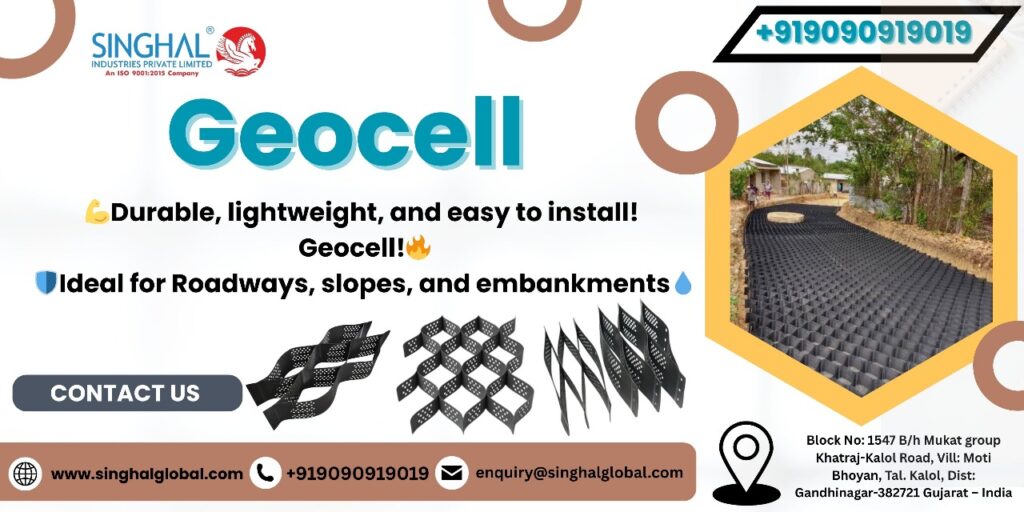Soil. It’s the soil under our feet, the base of our roads, driveways, and the most impressive structures that we admire. But anyone who’s worked in construction knows how unstable the soil is. It shifts, it breaks down, and it becomes weaker. For decades, engineers fought to tame this unstable foundation. There was a breakthrough: geocells. From stabilizing a driveway with geocells to stabilizing a Geocell driveway India to supporting huge runways and highways in the world, geocells are altering the rules for stabilization of soil. What made this technology advance, and why is it a top option for contractors, engineers, and even homeowners? Let’s look at it more closely.
The First Problems with Stabilization of Soil
Prior to geocells, stabilization of soil was largely dependent on concrete, gravel, as well as chemical treatment. They worked, but only to a certain point. Examples:
- Concrete slabs cracked by massive loads.
- Chemical stabilizers have damaged the environment.
- Driveways made of gravel require replenishing following rain.
I can remember a tiny road construction project close to my home in Rajasthan. The engineers employed only bitumen and gravel layers. This was the moment I heard about Geocell in road construction, a solution that promised durability, flexibility, and stability.
What Exactly Are Geocells?
After being expanded and then filled up with gravel, soil, or sand, they make a solid and stable structure that holds everything in position. Think of it as the egg container. Similar to how the egg carton stops eggs from rolling or breaking, geocells stop soil from shifting under the weight of loads. This simple principle has revolutionized construction practices all over the world.
The Evolution of Geocells
Geocells aren’t something that’s brand new. They were developed by the U.S. Army Corps of Engineers in the 1970s to build roads quickly and stably to support military operations in difficult terrains. In the years that followed, Geocell manufacturers in india and civil engineers developed the model to be used by civilians. Geocells of today are lightweight, easy to carry, and extremely adaptable. They’re no longer restricted to military roads; they are used for landscaping, railways, slope protection, and even for creating environmentally friendly driveways.
Applications: From Highways to Home Projects
One of the fascinating aspects of geocells is the fact that they are widespread.
Geocells in Road Construction
Highways in India, particularly those in states with black cotton soils, gain by geocells because they enhance capacity for load bearing and lower the cost of maintenance.
Geocell Driveway
Indian homeowners are increasingly embracing geocells to construct sturdy, edgy driveways that won’t be swept away during monsoons.
Railways and Airports
Heavy load-bearing zones make use of geocells to spread pressure more evenly, decreasing the chance of a surface failing.
Recently, I visited a house close to Pune in India where the owner utilized a geocell driveway instead of pavers. The result was spectacular—it was neat, able to handle rain with ease, and needed minimal maintenance. He said he was initially skeptical as the initial cost was high, and in only two years, the owner discovered it was much cheaper than fixing a damaged concrete driveway each monsoon.
Why Geocells Are a Game-Changer
- Cost Savings – While the initial cost might be more expensive, maintenance over the long term is greatly decreased.
- Environmentally friendly – In contrast to chemical compounds, geocells are constructed out of recycled materials and help encourage plant growth.
The combination of durability, strength, and aptitude makes geocells the future of soil stabilization.
Contradictions and Concerns
Of course, no solution is ideal. Many argue that geocells are expensive for small-scale projects. Some are concerned about the material used, HDPE; even though it can be recycled, it remains a petroleum-based product. Here’s the problem: when you construct a road that is not geocell-free, repeated repairs and resurfacing could result in more financial and environmental damage over the long term. So, is the greater initial investment really more sustainable? In my opinion, yes.
The Growing Industry of Geocell Manufacturers
Many geocell companies offer products to both international and domestic markets, providing customized solutions. India, particularly, is gaining momentum as a key market due to its low-cost manufacturing and highly skilled engineering team.
In the world, numerous large-scale projects—highways in China, airports throughout the Middle East, railways in Europe, and so on—use geocells as a common stabilization technique. In addition, with the development of biodegradable geocells being developed, the future is looking greener.
Building Trust in Soil
In the eyes of engineers, soil is a friend and a foe. It is the foundation of everything we construct; however, it can also deceive us when it shifts or collapses. Geocells, in a sense, can restore trust towards the earth. They don’t take away soil; they just improve it. I’m sure that’s why numerous engineers have a personal connection to the technology. It’s not only about creating stronger roads; it’s about gaining confidence in the soil we walk on.
The Future of Geocells
Geocells appear likely to play an increasing role in ensuring sustainable infrastructure. Imagine driveways that remain intact for years, roads that don’t break down during the monsoons, and slopes that remain stable and green. For large-scale projects, geocell road construction might be the solution to reduce the cost of maintenance on national highways.
Conclusion
What started as a military necessity has become an engineering marvel for civil engineers. Geocells stabilize soil in ways we didn’t think possible; they are transforming the way we construct roads, driveways, and even landscapes. The next time you travel on a smooth road following heavy rain, or walk along an attractive driveway that isn’t cracked, take note that it’s not just concrete or gravel working. It’s geocells, the silent revolution beneath your feet.
Frequently Asked Questions (F&Q)
Q1. Are geocells cut to accommodate particular shapes?
Yes, geocells can be flexible and can be cut to fit specific dimensions of projects which makes them extremely adaptable.
Q2. What is the geocells maximum load?
Depending on the size of the cell and filling material, geocells can support a load of light-car driveways to heavy-weight highway traffic.
Q3. Do geocells fit the specifications of the environment?
Geocells contemporary manufacturers prepare products, which are in tandem with world safety and environmental standards. They also have recyclable and environmentally friendly models.
Q4. Does it make sense to use geocells in the construction of roads?
Absolutely. One of the most popular applications is geocells used in road construction because it may minimize the risk of rutting, increase its life cycle, and minimize maintenance.
Q5. Who is the largest manufacturers of geocell?
In the world, many companies compete in this field; however, Singhal Industries Pvt. Ltd. is one of the top and most reliable geocell manufacturers that serve both Indian and international markets.









